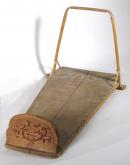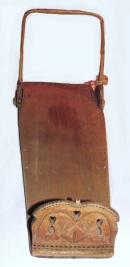The Northeast region includes portions of southeastern Canada, and is bordered in the United States by the Mississippi River and Atlantic Coast. The tribes of this region represented in the Museum’s cradleboard collection are the Iroquois (4) and (1) Oneida example specifically, Menominee (1), Mexican Kickapoo (2), Ojibwa/Chippewa (7), Potawatomi (3), Sauk (1), and Winnebago/Ho-Chunk (3).
The term “cradleboard” was inspired by the Northeastern cradle style. The typical design incorporates a flat rectangular, triangular, or trapezoidal backboard, usually about 60 centimeters long, with a curved wooden bow, or hoop. The ends of the bow insert into a carved wooden brace laid across the underside of the backboard and usually attached to it with hide lacing, nails, or screws. The main purpose of the bow was to protect the baby’s head should the cradle fall, but it was also frequently draped with a cloth or blanket to keep the child comfortable depending on the weather. Toys and amulets were frequently hung from the bow for the child’s amusement and spiritual protection. A wooden footrest or curved wooden foot guard was sometimes added and was generally nailed or laced to the backboard. Babies were often swaddled with sphagnum moss, shredded bark or rabbit or weasel skins which could act as a diaper, and then they were entirely wrapped with a blanket of hide or cloth. The swaddled child was secured to the board with cloth or hide bands and fastened with lacings. Two bands were common, one wrapped across the legs and another around the torso. Older bands were made of hide and sparsely decorated, while elaborate bead and porcupine quill floral designs, as well as geometric cloth appliqué were more frequently seen after the introduction of velvet and broadcloth.
While most Native groups carried their cradles with a textile or leather strap tumpline laid across an adult’s forehead or chest, some groups like the Kickapoo only carried their children in their arms. If a cradle wasn’t to be had, mothers frequently placed their children on their back secured by a blanket. In the home, babies were often placed in hammocks or unwrapped and allowed to explore.
Some variations exist among Northeastern designs. Most cradles utilized a U-shaped foot guard that framed the child’s legs, but Iroquois cradles frequently included only a footrest in their designs. On some Potawatomi, Ojibwa, and Winnebago cradles, shapes or tabs were carved as decoration on the portions of the bow brace that extended beyond the backboard. In most Northeastern cradles, the only decoration was glass beads, ribbon, or quillwork on the wrapping bands or an ornament hung from the bow, but some Ojibwa and Iroquois cradles were decorated with incised carving and paint. Iroquois artists have created some of the most elaborate examples, often covering the entire exterior of the backboard with elaborate floral designs in a variety of colors.











